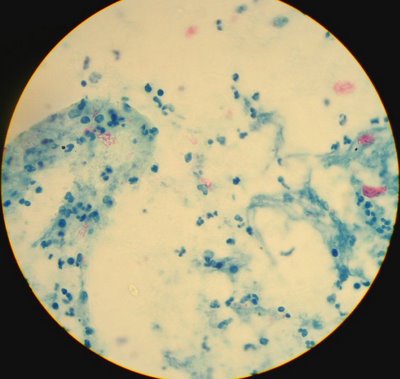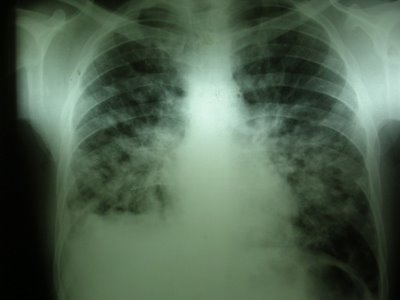This is Tuberculosis....you know, that old disease, it's coming back.
We killed the weak versions of the disease, leaving the strong, nasty ones. Now we have multi-drug resistant strains. Here's how it works.... You get TB. You take the drugs. The drugs kill 99% of the bugs. you feel better, so don't finish your medication regime. That 1% that lived, though, are the toughest, hardiest 1%. They multiply, reinfecting you with a stronger, tougher strain of Tb thats now resistant to that specific drug. This is happening with all the bacteria. There's antibiotic  resistant strains of just about every organism out there. Why? because we overprescribe antibiotics, don't take them right, and the pharmaceutical companies aren't discovering any new antibiotics. Scary stuff.
resistant strains of just about every organism out there. Why? because we overprescribe antibiotics, don't take them right, and the pharmaceutical companies aren't discovering any new antibiotics. Scary stuff.
PRAGUE, September 10, 2006
 resistant strains of just about every organism out there. Why? because we overprescribe antibiotics, don't take them right, and the pharmaceutical companies aren't discovering any new antibiotics. Scary stuff.
resistant strains of just about every organism out there. Why? because we overprescribe antibiotics, don't take them right, and the pharmaceutical companies aren't discovering any new antibiotics. Scary stuff.PRAGUE, September 10, 2006
(RFE/RL) -- Experts from the World Health Organization (WHO) met this week in Johannesburg, South Africa, to address a worrying development in the fight against tuberculosis -- the emergence of an extreme drug resistant strain that is virtually incurable.
It is a medical paradox that has public-health workers very worried. Powerful drugs meant to cure people of tuberculosis are indirectly killing them instead.
And the World Health Organization (WHO) is raising the alarm.
For years, doctors have been battling multi-drug resistant cases of tuberculosis using ever-stronger pharmaceuticals called second-line drugs.
But if those strong pharmaceuticals are not used as prescribed, they can give rise to a new strain of extreme drug-resistant tuberculosis.
And that has no cure.
In Eastern Europe and the former Soviet Union, where there has been a resurgence of tuberculosis, cases of the extreme drug-resistant variant are rising fast. "The treatment of TB, in general, has to follow some fundamental principles," says Ernesto Jaramillo, a WHO medical officer at the Johannesburg conference. "First of all, the treatment regimen has to be properly designed and should consist of a cocktail with the right drugs, that should be delivered in the right way. If medical doctors prescribe the wrong drugs, and or if the patient does not take the drugs properly, then the obvious consequence is that -- over time -- drug resistance develops."
A recent outbreak in South Africa of what scientists call extreme drug-resistant tuberculosis, or XDR-TB, killed 52 out of 53 patients infected.
In Eastern Europe and the former Soviet Union, where there has been a resurgence of tuberculosis, cases of the extreme drug-resistant variant are rising fast.
Latvia is one example. According to the World Health Organization, it has one of the highest rates. Every fifth case of multi-drug resistant tuberculosis in the country has already morphed into the extreme drug-resistant type.
Russia, Ukraine, and the Central Asian countries, where tuberculosis cases among prisoners have reached epidemic proportions, could soon face the same problem.
This is largely due to a breakdown of the health services in the post-Communist era.
Complex Treatment
Patients who suffer from multi-drug resistant tuberculosis have to take a cocktail of medicines for a long period of time. That is expensive and requires close doctor supervision.
If treatments are skipped or medicines are taken out of sequence, the disease is not cured and can metamorphose into the extreme drug-resistant variety.
Jaramillo says the meeting in Johannesburg will start working on guidelines for health-care workers worldwide, to stop the rise of extreme drug resistant tuberculosis.
In the meantime, he says the most important thing doctors and patients can do is to follow the precise course of treatment. Jaramillo emphasizes that this will save money and lives in the long run.
“What we are going to do is to set up a task force that will be reviewing the current situation and making precise recommendations by the end of the year about how to tackle [extreme drug-resistant TB]," he says. "But in the meantime, what we are strongly recommending is to ensure that second-line drugs -- the drugs used to treat [multi-drug resistant] TB -- are properly used. The rational use of second-line drugs is the most powerful way to prevent the creation of extreme drug-resistant TB."
The WHO is also trying to persuade pharmaceutical companies to offer discounted drugs to countries in need, to avoid an epidemic of extreme drug-resistant tuberculosis, before it is too late.
"There has been important progress in recent years," Jaramillo says. "One major pharmaceutical company has embarked on transferring technology for producing two key drugs. However, the treatment regimens for multi-drug resistant TB consist of at least four drugs. So although there is progress it is still not enough for what we need."

It is a medical paradox that has public-health workers very worried. Powerful drugs meant to cure people of tuberculosis are indirectly killing them instead.
And the World Health Organization (WHO) is raising the alarm.
For years, doctors have been battling multi-drug resistant cases of tuberculosis using ever-stronger pharmaceuticals called second-line drugs.
But if those strong pharmaceuticals are not used as prescribed, they can give rise to a new strain of extreme drug-resistant tuberculosis.
And that has no cure.
In Eastern Europe and the former Soviet Union, where there has been a resurgence of tuberculosis, cases of the extreme drug-resistant variant are rising fast. "The treatment of TB, in general, has to follow some fundamental principles," says Ernesto Jaramillo, a WHO medical officer at the Johannesburg conference. "First of all, the treatment regimen has to be properly designed and should consist of a cocktail with the right drugs, that should be delivered in the right way. If medical doctors prescribe the wrong drugs, and or if the patient does not take the drugs properly, then the obvious consequence is that -- over time -- drug resistance develops."
A recent outbreak in South Africa of what scientists call extreme drug-resistant tuberculosis, or XDR-TB, killed 52 out of 53 patients infected.
In Eastern Europe and the former Soviet Union, where there has been a resurgence of tuberculosis, cases of the extreme drug-resistant variant are rising fast.
Latvia is one example. According to the World Health Organization, it has one of the highest rates. Every fifth case of multi-drug resistant tuberculosis in the country has already morphed into the extreme drug-resistant type.
Russia, Ukraine, and the Central Asian countries, where tuberculosis cases among prisoners have reached epidemic proportions, could soon face the same problem.
This is largely due to a breakdown of the health services in the post-Communist era.
Complex Treatment
Patients who suffer from multi-drug resistant tuberculosis have to take a cocktail of medicines for a long period of time. That is expensive and requires close doctor supervision.
If treatments are skipped or medicines are taken out of sequence, the disease is not cured and can metamorphose into the extreme drug-resistant variety.
Jaramillo says the meeting in Johannesburg will start working on guidelines for health-care workers worldwide, to stop the rise of extreme drug resistant tuberculosis.
In the meantime, he says the most important thing doctors and patients can do is to follow the precise course of treatment. Jaramillo emphasizes that this will save money and lives in the long run.
“What we are going to do is to set up a task force that will be reviewing the current situation and making precise recommendations by the end of the year about how to tackle [extreme drug-resistant TB]," he says. "But in the meantime, what we are strongly recommending is to ensure that second-line drugs -- the drugs used to treat [multi-drug resistant] TB -- are properly used. The rational use of second-line drugs is the most powerful way to prevent the creation of extreme drug-resistant TB."
The WHO is also trying to persuade pharmaceutical companies to offer discounted drugs to countries in need, to avoid an epidemic of extreme drug-resistant tuberculosis, before it is too late.
"There has been important progress in recent years," Jaramillo says. "One major pharmaceutical company has embarked on transferring technology for producing two key drugs. However, the treatment regimens for multi-drug resistant TB consist of at least four drugs. So although there is progress it is still not enough for what we need."

This Xray of lungs shows the puffy white regions associated with TB, They should look black( full of air), with clearly defined margins.



0 Comments:
Post a Comment
<< Home